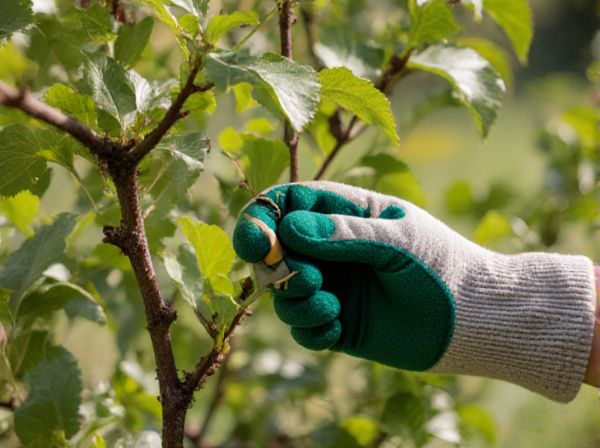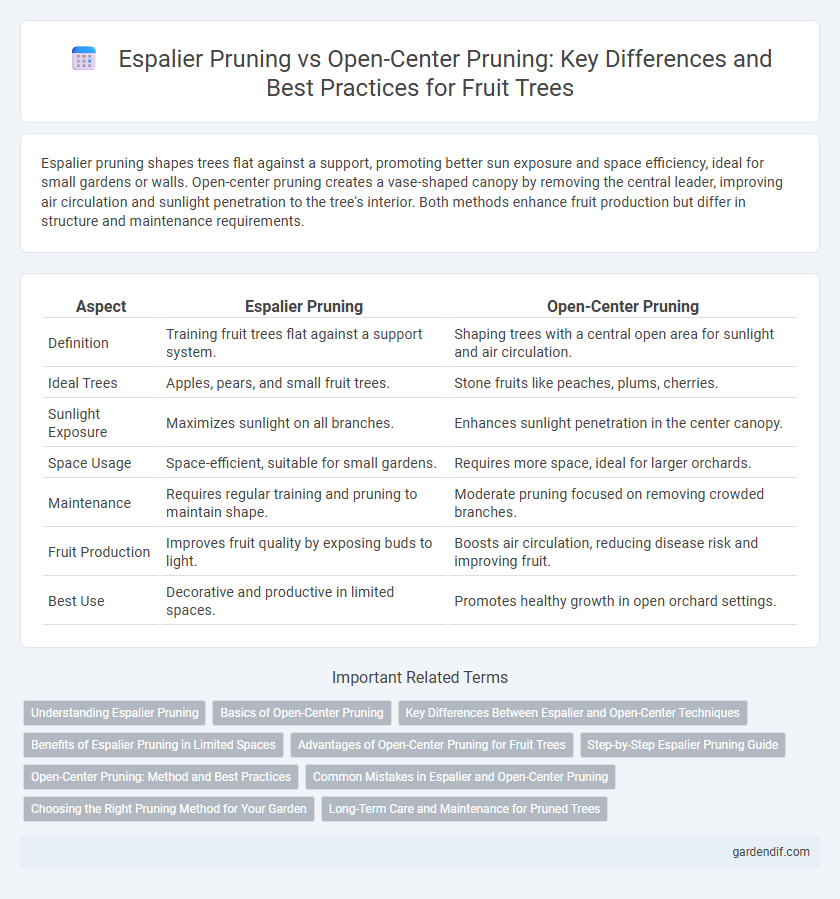
Espalier pruning vs open-center pruning Illustration
Espalier pruning shapes trees flat against a support, promoting better sun exposure and space efficiency, ideal for small gardens or walls. Open-center pruning creates a vase-shaped canopy by removing the central leader, improving air circulation and sunlight penetration to the tree's interior. Both methods enhance fruit production but differ in structure and maintenance requirements.
Table of Comparison
| Aspect | Espalier Pruning | Open-Center Pruning |
|---|---|---|
| Definition | Training fruit trees flat against a support system. | Shaping trees with a central open area for sunlight and air circulation. |
| Ideal Trees | Apples, pears, and small fruit trees. | Stone fruits like peaches, plums, cherries. |
| Sunlight Exposure | Maximizes sunlight on all branches. | Enhances sunlight penetration in the center canopy. |
| Space Usage | Space-efficient, suitable for small gardens. | Requires more space, ideal for larger orchards. |
| Maintenance | Requires regular training and pruning to maintain shape. | Moderate pruning focused on removing crowded branches. |
| Fruit Production | Improves fruit quality by exposing buds to light. | Boosts air circulation, reducing disease risk and improving fruit. |
| Best Use | Decorative and productive in limited spaces. | Promotes healthy growth in open orchard settings. |
Understanding Espalier Pruning
Espalier pruning involves training fruit trees to grow flat against a structure, maximizing sunlight exposure and air circulation for better fruit production in limited spaces. This method requires precise, regular pruning to maintain the desired two-dimensional shape, promoting healthy growth and easier harvesting. Compared to open-center pruning, espalier is more labor-intensive but ideal for small gardens or urban environments seeking efficient space use.
Basics of Open-Center Pruning
Open-center pruning involves creating a vase-shaped tree structure by removing the central leader and encouraging outward-facing branches, which enhances air circulation and sunlight penetration. This method is commonly used for stone fruit trees like peaches and plums to reduce disease risk and improve fruit quality. Unlike espalier pruning, which trains branches flat against a support, open-center pruning allows a more natural, three-dimensional canopy development.
Key Differences Between Espalier and Open-Center Techniques
Espalier pruning shapes trees flat against a support, optimizing space and sunlight exposure in narrow areas, while open-center pruning encourages a vase-shaped canopy for better air circulation and light penetration in wider spaces. Espalier involves training branches horizontally along a framework, maximizing fruit production on limited surfaces, whereas open-center pruning removes central branches to open up the crown and reduce disease risk. The choice between these methods depends on orchard design, tree species, and desired maintenance intensity.
Benefits of Espalier Pruning in Limited Spaces
Espalier pruning maximizes fruit production in limited spaces by training branches along a flat plane, enhancing sunlight exposure and air circulation. This method reduces the tree's footprint, making it ideal for small gardens or urban environments where space is constrained. Improved accessibility for maintenance and harvesting further elevates its benefits compared to open-center pruning.
Advantages of Open-Center Pruning for Fruit Trees
Open-center pruning promotes better sunlight penetration and air circulation within the canopy, reducing the risk of disease and improving fruit quality. This method creates an open framework that simplifies harvesting and pest management, enhancing overall tree health and productivity. By maintaining a strong structure with well-spaced branches, open-center pruning supports larger, more accessible fruit growth compared to espalier pruning.
Step-by-Step Espalier Pruning Guide
Espalier pruning involves training fruit trees to grow flat against a support structure, maximizing space and increasing sunlight exposure for better fruit production. The step-by-step Espalier pruning guide includes selecting a young, flexible tree, establishing a central leader, and carefully pruning lateral branches to create horizontal tiers that encourage balanced growth. This method differs from open-center pruning, which shapes trees with an open canopy, allowing air circulation but requiring more space.
Open-Center Pruning: Method and Best Practices
Open-center pruning involves removing the central leader to create a vase-shaped tree with an open middle, enhancing sunlight penetration and air circulation. The method focuses on selecting scaffold branches spaced evenly around the trunk and cutting back vigorous shoots to maintain structure and encourage fruiting wood. Best practices include pruning during dormancy, avoiding heavy cuts that stress the tree, and regularly thinning crowded growth to promote healthy development.
Common Mistakes in Espalier and Open-Center Pruning
Common mistakes in espalier pruning include cutting too aggressively, which can damage the main framework, and failing to maintain proper tension on training wires, resulting in uneven growth patterns. In open-center pruning, improper removal of central branches can lead to a weak structure, while neglecting to thin out dense foliage reduces air circulation and sunlight penetration. Both methods require precise cuts and regular maintenance to promote healthy growth and maximize fruit production.
Choosing the Right Pruning Method for Your Garden
Espalier pruning shapes trees against flat surfaces, maximizing space and sunlight exposure, ideal for small gardens or tight spaces. Open-center pruning creates a vase-like canopy, promoting air circulation and fruit production, making it suitable for larger fruit trees. Selecting the right method depends on garden size, tree species, and desired yield, ensuring optimal growth and maintenance.
Long-Term Care and Maintenance for Pruned Trees
Espalier pruning requires consistent long-term care, including annual training and careful removal of competing shoots to maintain its flat, structured form and promote healthy growth. Open-center pruning demands regular thinning and selective branch cuts each season to improve air circulation, light penetration, and reduce disease risk in the tree's central canopy. Both methods benefit from ongoing monitoring for pest control and nutrient management to ensure balanced development and tree longevity.
Espalier pruning vs open-center pruning Infographic

 gardendif.com
gardendif.com